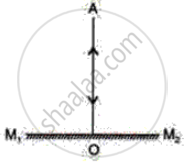Advertisements
Advertisements
प्रश्न
David is observing his image in a plane mirror. The distance between the mirror and his image is 4 m. If he moves 1 m towards the mirror, then the distance between David and his image will be ______.
विकल्प
3 m
5 m
6 m
8 m
उत्तर
David is observing his image in a plane mirror. The distance between the mirror and his image is 4 m. If he moves 1 m towards the mirror, then the distance between David and his image will be 6 m.
Explanation:
If David moves 1 m towards the mirror, then the distance between his image and mirror = 4 - 1 = 3m
So, the distance between David and the mirror = 3
Hence, distance between David and his image = 3 + 3 = 6m
APPEARS IN
संबंधित प्रश्न
Fill in the blank
A plane mirror _________ reflects 100 percent light falling on it.
Explain the following term:
Reflected ray
Draw diagram/diagrams to show them.
Figure shows an incident ray AO and the normal ON on a plane mirror. The angle which the incident ray AO makes with mirror is 30°. (a) Find the angle of incidence. (b) Draw the reflected ray and then find the angle between the incident and reflected rays.

The diagram in Figure shows a point object P in front of a plane mirror MM1.

(a) Complete the diagram by taking two rays from the point P to show the formation of its image.
(b) In the diagram, mark the position of eye to see the image.
(c) Is the image formed real or virtual? Explain why?
Describe the principle of simple periscope through an outline ray diagram. Give one of its uses.
An object OA is placed on the principal axis of a concave mirror as shown in the figure. Copy and complete the diagram to show the formation of image.

The reflection of a ray of light (OA) normally incident on a plane mirror is shown below

What are the angles of incidence and reflection?
A ray of light is travelling in a direction perpendicular to the boundary of a parallel glass slab. The ray of light ______.
The light falling on the mirror is called as ______ and the light reflected is called reflected ray.
